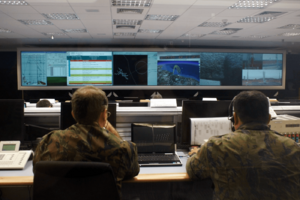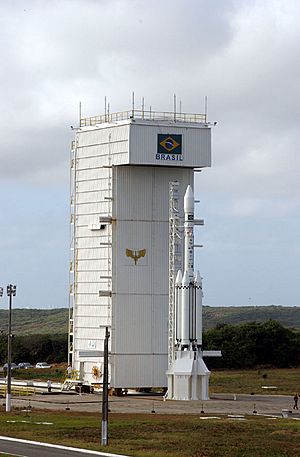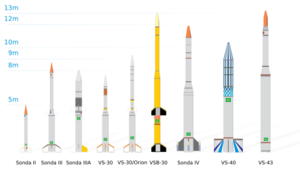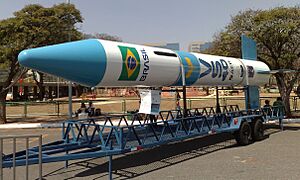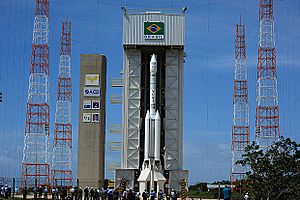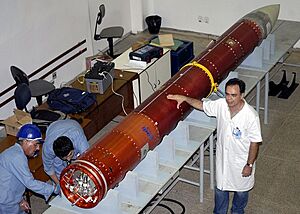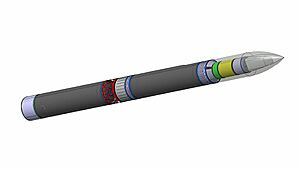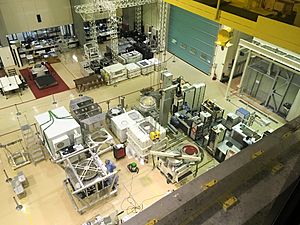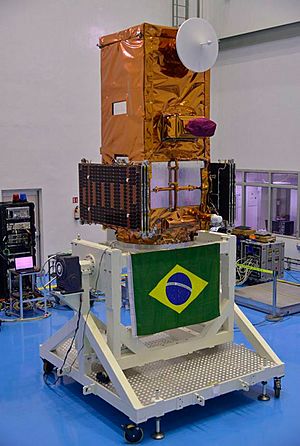Brazilian Space Agency facts for kids
| Agência Espacial Brasileira | |
 |
|
| Agency overview | |
|---|---|
| Abbreviation |
|
| Formed | 10 February 1994 |
| Preceding agency |
|
| Type | Space agency |
| Headquarters | Brasília, Distrito Federal |
| Official language | Portuguese |
| Administrator | Marco Antonio Chamon |
| Primary spaceport | Alcântara Space Center |
| Owner | Government of Brazil |
| Annual budget | R$180 million / US$45 million (2019) |
The Brazilian Space Agency (AEB) is Brazil's main organization for space. It is in charge of the country's space program. The AEB runs a spaceport at Alcântara and a rocket launch site at Barreira do Inferno. It is the biggest space agency in Latin America.
The AEB took over from Brazil's earlier space program, which was run by the military until 1994. In 2003, a rocket explosion was a big setback, sadly killing 21 technicians. But Brazil kept going! On October 23, 2004, they successfully launched their first rocket, the VSB-30, from Alcântara. Many more successful launches have happened since then.
Brazil was also a partner in the International Space Station for a short time. In 2006, AEB astronaut Marcos Pontes became the first Brazilian to go to space. He spent a week on the ISS, doing eight experiments for the Brazilian Space Agency. In June 2021, the AEB joined the Artemis Accords. This means they are working with other countries to explore the Moon and Mars.
Contents
History of Brazil's Space Journey
Brazil's space journey began in 1960. The president at the time, Jânio Quadros, started a group to plan a national space program. This led to the creation of the Organization Group of the National Commission of Space Activities (GOCNAE) in 1961. Researchers from this group worked on international projects in astronomy, geodesy, and meteorology.
In 1971, the GOCNAE became the National Institute for Space Research (INPE). Brazil has been following space progress since 1946, when the Technical Center of Aeronautics (now the Department of Aerospace Science and Technology - DCTA) was formed.
The Technological Institute of Aeronautics (ITA) trains skilled people for advanced technology. The DCTA, along with ITA and the Institute of Aeronautics and Space (IAE), are very important for Brazil's space program.
In the early 1970s, the Brazilian Space Activities Commission (COBAE) was created. It helped guide the space program. Then, in February 1994, the Brazilian Space Agency (AEB) was formed. This was a big change, making the space program's main office report directly to the President of Brazil.
In 2011, Argentina suggested creating a single South American space agency, like the European Space Agency. But in 2015, Brazil's Space Agency and Ministry of Defense said no. They felt it would create too much paperwork and not enough results. They also thought Brazil would end up paying most of the costs.
Where Brazil Launches Rockets
Alcântara Space Center
2°20′S 44°24′W / 2.333°S 44.400°W The Alcântara Launch Center (CLA) is the main place where the Brazilian Space Agency launches rockets. It is located on a peninsula in Alcântara. This spot is great because it does not have many people, is very safe, and is easy to reach by air and sea. The best part is how close it is to the Equator. This closeness helps rockets launch geosynchronous satellites more easily.
Barreira do Inferno Launch Center
5°55′30″S 35°9′47″W / 5.92500°S 35.16306°W The Barreira do Inferno Launch Center (CLBI) is another rocket launch base for the Brazilian Space Agency. It is in Parnamirim, Rio Grande do Norte. This center is mostly used to launch sounding rockets and to help out the Alcântara Launch Center.
Brazil's Rockets and Vehicles
Sounding Rockets
The Brazilian Space Agency has used several types of sounding rockets. These are smaller rockets that go into space but do not orbit Earth. They are used for scientific experiments.
- Sonda I
- Sonda II
- Sonda III
- Sonda IV
- VSB-30
- VS-30
- VS-40
- VS-50 (This one is still being planned and will use a new S-50 rocket engine.)
VLM Rockets
Brazil is working with Germany to build a special rocket for launching very small satellites. This rocket is called the VLM, which stands for "Microsatellite Launch Vehicle." It will be able to put satellites weighing up to 150 kg into orbit. The first test flight was planned for 2022 from Alcântara. Another flight is planned as part of the SHEFEX mission with the German Aerospace Center (DLR).
VLS Rockets
The VLS (Satellite Launch Vehicle) was the main rocket Brazil used to launch satellites. It was a four-stage rocket. The first stage used four solid-fuel motors, similar to those from the Sonda sounding rockets. It was designed to put satellites weighing 100 to 380 kg into orbit. The first three test rockets failed. The third one, in 2003, sadly exploded on the launch pad, killing 21 AEB workers. The VLS-1 project was stopped in 2016.
Southern Cross Program
The Brazilian Space Agency was developing a new group of rockets with Russia. These five rockets, called the Southern Cross family, would use Russian rocket technology. The program was named "Southern Cross" after the Crux constellation, which is on the flag of Brazil. The rockets were named:
- VLS Alfa (a lighter rocket)
- VLS Beta (another lighter rocket)
- VLS Gama (a lighter rocket that could carry almost 1 ton into orbit from Alcântara)
- VLS Delta (a medium-weight rocket)
- VLS Epsilon (a heavy-weight rocket that could carry 4 tons into orbit from Alcântara)
Brazil had planned to spend a lot of money on this project. However, the program was later canceled. Instead, Brazil decided to focus on smaller rockets using more of its own technology.
14-X Hypersonic Vehicle
Brazil is also working on very fast technology called hypersonic technology. The 14-X is a special vehicle being developed with the Brazilian Air Force. It was launched on February 14, 2022, by a VSB-30 rocket. It reached an altitude of 100,000 feet and a top speed of Mach 10 (10 times the speed of sound!).
Rocket Engines
Many different engines have been made for Brazil's rockets:
- S-10-1 solid rocket engine: Used on Sonda 1.
- S-10-2 solid rocket engine: Also used on Sonda 1.
- S-20 Avibras solid rocket engine: Used on Sonda 2 and Sonda 3.
- S-23 Avibras solid rocket engine: Used on Sonda 3M1.
- S-30 IAE solid rocket engine: Used on Sonda 3, Sonda 3M1, Sonda 4, VS-30, VS-30/Orion, and VSB-30.
- S-31 IAE solid rocket engine: Used on VSB-30.
- S-40TM IAE solid rocket engine: Used on VLS-R1, VS-40, VLS-1, and VLM-1.
- S-43 IAE solid rocket engine: Used on Sonda 4, VLS-R1, and VLS-1.
- S-43TM IAE solid rocket engine: Used on VLS-R1, VLS-1, and VLM.
- S-44 IAE solid rocket engine: Used on VLS-R1, VS-40, VLS-1, and VLM-1.
- L5 liquid fuel rocket engine: Tested on VS-30 and planned for VLS-Alfa.
- L15 liquid fuel rocket engine: Planned for VS-15.
- L75 liquid fuel rocket engine: Planned for VLS-Alfa, VLS-Beta, VLS-Omega, VLS-Gama, and VLS-Epsilon.
- S-50 IAE solid rocket engine: Planned for VLM-1 and VS-50.
- L1500 liquid fuel rocket engine: Used on VLS-Beta, VLS-Omega, VLS-Gama, and VLS-Epsilon.
Satellites in Space
The Brazilian Space Agency has many satellites orbiting Earth. These satellites help with things like taking pictures of Earth, military communications, and observing our planet. Several new satellites are also being developed.
| Satellite | Origin | Type | Operational | Status |
| SCD1 | Earth observation |
1993–
|
Active | |
| SCD2 | Earth observation |
1998–
|
Active | |
| CBERS-1 | Earth observation |
1999–2003
|
Retired | |
| CBERS-2 | Earth observation |
2003–2007
|
Retired | |
| CBERS-2B | Reconnaissance |
2007–2010
|
Retired | |
| CBERS-3 | Earth observation |
2013
|
Launch failure | |
| CBERS-4 | Earth observation |
2014–
|
Active | |
| SGDC-1 | Communications satellite |
2017–
|
Active | |
| CBERS-4A | Earth observation |
2019–
|
Active | |
| Amazônia-1 | PMM - "Plataforma Multimissão" (Multi-mission Platform) |
2021–
|
Active | |
| SGDC-2 | Communications satellite |
2020s
|
Planned | |
| SABIA-Mar 1 | PMM - "Plataforma Multimissão" (Multi-mission Platform) |
2020s
|
Planned | |
| Amazônia-1B | PMM - "Plataforma Multimissão" (Multi-mission Platform) |
2020s
|
Planned | |
| Amazônia-2 | PMM - "Plataforma Multimissão" (Multi-mission Platform) |
2020s
|
Planned | |
| GEOMET-1 | Earth observation |
2020s
|
Planned | |
| LATTES-1 | Space weather (EQUARS) and X-ray space telescope (MIRAX) mission |
2020s
|
Planned | |
| SABIA-Mar 2 | PMM - "Plataforma Multimissão" (Multi-mission Platform) |
2020s
|
Planned | |
| Carponis | Remote sensing |
2020s
|
Planned |
Brazilian Astronauts
Marcos Pontes, a lieutenant colonel in the Brazilian Air Force, is an astronaut for the Brazilian Space Agency. He was the first Brazilian astronaut. He launched into space on March 29, 2006, aboard a Soyuz-TMA spacecraft from Kazakhstan. Pontes arrived at the International Space Station (ISS) on March 31, 2006. He lived and worked there for 9 days. He returned to Earth on April 8, 2006. From 2019 to 2022, Pontes served as Brazil's Minister of Science, Technology, Innovation, and Communication.
| Name | Position | Time in space | Launch date | Mission | Mission insignia | Status | |
 |
Marcos Pontes | Mission Specialist | 9d 21h 17m | March 30, 2006 | Soyuz TMA-8 Missão Centenário Soyuz TMA-7 |
Active, on stand-by |
Space Operations in Brazil
Aerospace Operations Command
The Aerospace Operations Command (COMAE) is a Brazilian air and space command. It was created in 2017 and is part of the Brazilian Air Force. This command plans, coordinates, and controls Brazil's air and space activities. The Brazilian Navy and Brazilian Army also work with this organization.
Space Operations Center
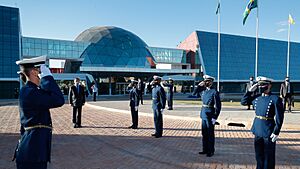
The Space Operations Center (COPE) was opened in 2020. It works under the Aerospace Operations Command. Its job is to operate and watch over Brazil's satellites.
Bingo Radio Telescope
The Bingo radio telescope is a big project. It is coordinated by Brazil's Ministry of Science, Technology and Innovation, the Brazilian Space Agency, the National Institute for Space Research (INPE), and international partners. The telescope will have two huge dishes, each 40 meters wide. These dishes will collect radio waves from space. Most of the parts for Bingo were made in Brazil.
Working with Other Countries
Cooperation with China: CBERS
China and Brazil have worked together very well in space. One of their most successful projects is the China–Brazil Earth Resources Satellite program (CBERS). This program develops and operates Earth observation satellites. Brazil and China have worked on the CBERS project for many years, launching six satellites together. These projects have helped both countries get satellite images and learn more about remote sensing. This cooperation is a great example of two developing countries working together in space.
International Space Station Partnership
The Brazilian Space Agency was a partner with NASA for the International Space Station. They signed an agreement in 1997 to develop equipment for the Space Station. In return, NASA would let Brazil use its facilities on the ISS and give one Brazilian astronaut a chance to fly to space. However, due to cost problems, Brazil left the program in 2007. As a compromise, NASA funded small Brazilian-made parts for the Express Logistics Carrier-2 on the ISS, which were installed in 2009.
Cooperation with Ukraine: Ciclone 4
In 2003, the Brazilian Space Agency and Ukraine's space agency created a joint company called Alcântara Cyclone Space. This company planned to launch satellites from the Alcântara Launch Center using the Tsyklon-4 rocket. Brazil invested money into building a new launch pad. The first launch was planned for 2014. However, Brazil pulled out of this program in 2015.
Cooperation with Japan
In 2010, the National Institute for Space Research (INPE) and the Japan Aerospace Exploration Agency (JAXA) agreed to work together. They focused on programs like monitoring illegal logging in the Amazon rainforest using satellite data. Both Brazil and Japan are also part of the Global Precipitation Measurement project, which studies rainfall.
Artemis Program
On October 21, 2020, the United States invited Brazil to join NASA's Artemis Space Program. Brazil officially joined on June 15, 2021, by signing the Artemis Accords. This agreement means they will work with the U.S. and other international partners to explore the Moon and Mars. Brazil's role includes developing a special lunar robot for future missions.
BRICS Satellite Constellation
On August 18, 2021, the AEB signed agreements with the space agencies of BRICS countries (Brazil, Russia, India, China, and South Africa). They are working together to develop a group of remote sensing satellites. These satellites will help with global challenges like climate change, big disasters, and protecting the environment. Ground stations in Brazil, Russia, India, China, and South Africa will receive data from these satellites.
More About Brazil in Space
- Aerospace Operations Command (Brazil's space command)
- Alcântara Space Center (CEA)
- National Institute for Space Research (INPE)
- Aerospace Technology and Science Department (DCTA)
- Technological Institute of Aeronautics (ITA)
- Embraer S.A. (A Brazilian aerospace company)
- Avibras (Another Brazilian aerospace company)
- List of government space agencies
- List of Brazilian satellites
See also
 In Spanish: Agencia Espacial Brasileña para niños
In Spanish: Agencia Espacial Brasileña para niños



